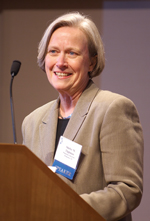|
|
Vol. 30 No. 3
May-June 2008
The Future of Science Is through Its Students
by Laure Joumel
Every year, the Chemical Heritage Foundation, based in Philadelphia, Pennsylvania, USA, holds the Ullyot Public Affairs Lecture, which emphasizes to the general public the positive role that the chemical and molecular sciences play in our lives. In November 2007, Shirley Tilghman, president of Princeton University spoke on “Strategy or Happenstance: Science Policy in the USA.” Tilghman chose the topic, she said, “because I believe in the profound importance of scientific discovery and innovation as an engine for economic and social progress.”
 |
Shirley Tilghman, president of Princeton University, delivers the 2007 Ullyot Public Affairs Lecture at the Chemical Heritage Foundation. |
To make her point, Tilghman enumerated the remarkable impact that science had in the 20th century: the dramatic increase in life expectancy, particularly in infants; the reduction in infant mortality; the virtual eradication of some diseases, such as small pox through systematic world-wide vaccinations; the invention of household conveniences that have freed us from manual labor; safe drinking water and sanitation; the power of television, radio, and film to foster greater understanding among peoples of different cultures; and in the development of the Internet. She added: “It’s been estimated by economists that upwards of 40 percent of the growth in the U.S. economy over the last 50 years has come from investments in fundamental research. What is remarkable is that most of these advances grew out of research in university laboratories and, often as not, research conducted by students and faculty pursuing knowledge for its own sake with no commercial application in mind. This remarkable progress did not happen by chance, so not happenstance.”
Next, Tilghman discussed the Program for International Student Assessment’s (PISA) 2006 survey, which revealed a pessimistic picture for science in the USA. PISA is an evaluation of 400 000 15-year-old students from 57 countries. It is the result of collaboration between participating countries and the Organization for Economic Co-operation and Development (OECD). The survey revealed that for 93 percent of students, science is important for understanding the natural world, but only 37 percent said they would like to work in a career involving science. The survey’s science performance measurement showed that USA is in the 21st position out of 30, while Finland is number one, Belgium 13, and France 19.
While young people’s motivations for science achievement goes down, paradoxically, the scientific budget follows. For the first time in 25 years, overall federal spending in the USA for academic research and development, after adjusting for inflation, fell in Fiscal Year 2006. In Fiscal Year 2004, federal funding in the physical sciences, as a fraction of GDP, was 54 percent less than in 1970. In engineering, it was 51 percent less. And although the total national R&D budget has been growing steadily for many years, the ratio of government-to-private-sector investing has reversed itself, from the government providing two-thirds of the total budget 45 ago to one-third today.
Tilghman said, “This retrenchment in the support of science and engineering could not come at a worse time, there are dangerous signs that America’s dominance in scientific competitiveness is at risk from newly rising economic powers, particularly in Asia.” She added, “Nearly 60 percent of patents filed in the USA in information technology now originate in Asia. We are not only losing our edge in what could be considered old manufacturing industries, such as textiles, steel, and automobiles, we are losing ground in areas that are considered the ‘new’ thing. Darwin famously said that it is not the strongest who survives, or even the most intelligent, but the individual who is most responsive to change. And, to change we have to be investing in innovation and creativity.”
Then Tilghman also shared a worried feeling on a completely different—but just as important—matter: the age of scientists when they get their jobs. In the 1950s and 1960s, the research enterprise expanded and created the next generation of scientists and faculty members. Eventually the problem became how to produce fewer students without having a negative effect on scientific productivity. In physics, there was a nationwide effort on the part of the American Physical Society to decrease graduate admissions from the 1980s to 1990s to adjust to the fact that there were no longer jobs for its graduates.
“In my own field of life sciences” she explained, “no such agreement could be reached and the number of students didn’t simply remain constant but, fueled by the National Institutes of Health (NIH) funding, continued to grow faster than the number of available jobs. Something had to give, and what gave was the length of time that students spend in training. This has resulted in young scientists who are in training well into their 30s, while their classmates from college are settling down, raising families, and adding to their pension plans. The average age of a first-time principal investigator at NIH is now 42.9 years. The age when you receive your first NIH grant. Aside from the personal cost to individual students, should we be worried that the late 30-somethings are still in training?”
In front of the large audience in Ullyot Meeting Hall at CHF, Tilghman concluded her talk with a warning: “There’s a pressing need for intelligent and open-minded discourse among scientists and policy makers so that together we can craft sound science policy for the United States at a time when its scientific preeminence is being challenged.”
Laure Joumel <[email protected]> is a freelance writer and a former Chemical Heritage Foundation-Travel Grant recipient. Based in Philadelphia, she currently works in the communications department of Arkema.
>
more on Tilghman's
presentation on chemheritage.org
website: www.chemheritage.org/events/event-nav2-ullyot.html
Page
last modified 5 June 2008.
Copyright © 2003-2008 International Union of Pure and
Applied Chemistry.
Questions regarding the website, please contact [email protected]
|